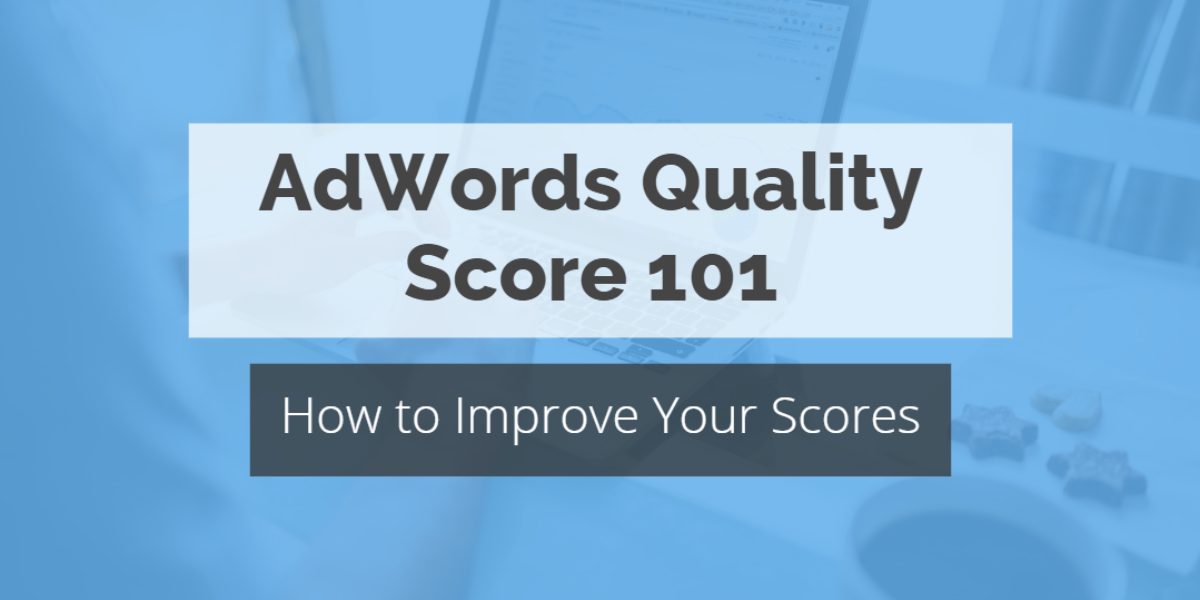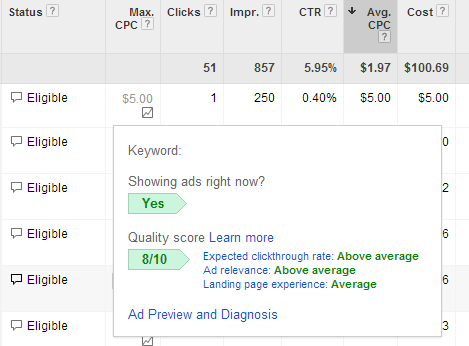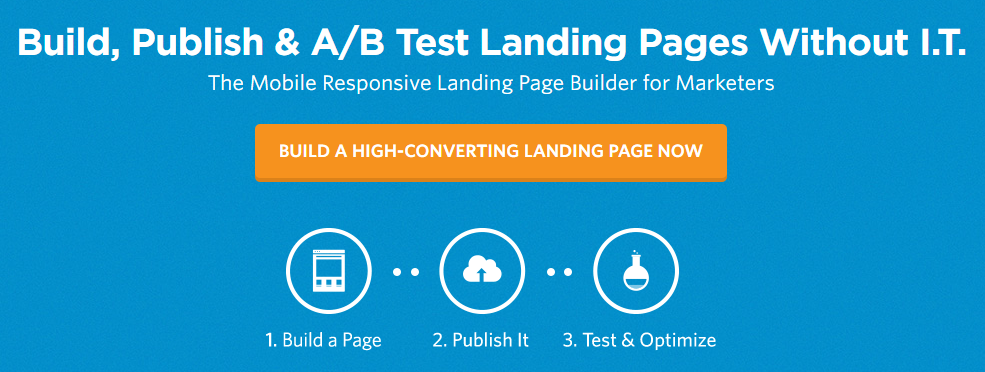
AdWords experts talk a lot about Quality Score and how important it is for getting better results, but we realized that not everyone understands how AdWords Quality Score system works and why it matters for your AdWords campaigns.
This post provides a detailed explanation about how Google’s Quality Score rating system works along with some tips on how you can improve your scores.
A Brief Introduction
“[Quality Score is] a grading system used by Google to determine if your ad is eligible to be shown in the sponsored space of the search results, at what position it will be shown, and how much you’ll pay for each click.”
That’s a short and sweet definition of what Quality Score is and why it matters for your PPC campaign performance. Continue reading for a longer, more in-depth definition and explanation.
An In-Depth Explanation of AdWords Quality Score
Quality Score is a rating on a scale of 1 to 10 (with 1 being the lowest score and 10 being the highest) that Google uses to measure the quality of the ads and landing pages triggered by a particular keyword.
The higher the Quality Score, the more relevant Google estimates your ads and landing pages will be in relation to the keyword being searched. Thus, the goal for every campaign is to improve the Quality Score for keywords as much as possible.
One thing to keep in mind, however, is that Quality Score is an estimate Google provides to give you an idea about how relevant they believe your ad and landing page will be for the keyword it’s being measured against, but they use another score called Ad Rank to determine whether or not your ad will be shown and when.
AdRank is a measurement Google uses to decide whether or not to show your ad based on its real-time calculation of the expected CTR, the ad relevance, and the estimated landing page experience (along with your bid and some other factors) for the exact search query that was entered.
Thus, AdRank is the actual, real-time score Google uses to determine when and where your ad shows up, and AdWords Quality Score is an estimation of this score that gives you a better idea about how your keyword, ad, and landing page combination will perform in AdWords’ live bidding system.
Why Does It Matter?
As mentioned above, AdWords uses the factors they estimate with Quality Score to determine your AdRank in real time which determines when and how your ads show up.
With that in mind, it’s in your best interest to improve your Quality Score for keywords by optimizing your QS in order to get a better ad placement, to get a higher CTR, and to get a lower CPC since Quality Score is a leading indicator of how Google will score your ad in real time.
So what factors should you be paying attention to in order to improve your Quality Score? Here are some of the most important factors to keep track of:
- The expected CTR for your ad based on past performance.
- The expected CTR for the display URL based on past performance.
- Landing page quality based on ease of use and relevance.
- The relevance of the ad related to the keyword being searched.
- The historic geographic performance of the ad based on the regions being targeted.
- Ad performance by device being used for the search.
The important thing to keep in mind is that your AdRank has a significant impact on your account performance which in turn means improving your average Quality Score should have a positive impact on your campaign. Here are some ways this rings true:
- Whether or not your ad gets shown: Google uses AdRank to determine whether or not your ad will get shown for a particular query. Thus, by improving your keyword Quality Score, you increase the chances that your ad will get shown more frequently.
- Cost Per Click (CPC): Not only does AdRank have an impact on whether or not your ad is shown, but it also impacts how much you eventually pay per click. This is true because Google tends to charge less per click for companies with a higher click through rate (CTR).
- Better Ad Position: Not only will your CPC likely go down, but your ad position will improve as your Quality Score goes up which in turn means your CTR rate is likely to go up based on your higher ad position. In turn, this means overall clicks for your campaign should go up as well.
- More Ad Extension Eligibility: Not only does AdRank impact where and when your ads show up, but it also determines whether or not your ad is eligible for ad extensions. Thus, if you’d like your ad to show up with ad extensions more often, then you need to improve your Quality Score which in turn will boost your AdRank score.
The bottom line is that a higher average AdWords Quality Score leads to better campaign results since it improves average ad position, increases CTR, and lowers CPC which leads to more clicks and more conversions at a lower CPA.
What’s not to like about that?
At the very least, Quality Score is a barometer PPC advertisers can use to estimate how closely their ads and landing pages match the keywords they’re paired with which has an impact on overall campaign results.
How Do You Check Your Score?
You check your score by clicking on “Keywords” and then hovering over the speech box to the left of the keyword. When you do, you’ll see the following:
This view shows you:
- Whether or not ads are being shown for that keyword (Yes or No).
- The Quality Score Google has assigned to the keyword based on the ad and landing page being shown with it (on a scale of 1 to 10).
- A rating for the expected click through rate, ad relevance, and landing page experience (below average, average, or above average).
What Score Should You Be Aiming for?
Obviously you want your score to be as high as possible, but no account will ever have a perfect scores of 10 across the board.
With this in mind, how can you know whether or not your Quality Scores are acceptable or whether or not they are below average? The chart below from TenScores provides a good rule of thumb to keep in mind.

As this chart points out, scores from 8 to 10 are excellent. If you have a lot of keywords in this range, you should pat yourself on the back.
A score of 7 is good, but you may want to look into how you can improve these scores to get a higher rating.
4-6 means your ads, landing pages, and offer alignment is weak. You may still convert some of this traffic, but there’s lot of room to improve your alignment and relevancy in order for these keywords to perform better.
1-3 means your keywords are not a good match for your ads or your landing page. If this is the case, you should consider culling these keywords or else find a way to create a better alignment between the keyword, the ads, and the landing page.
How Do You Improve Your Quality Score?
Let’s think for a moment about which factors affect your quality score. As we’ve discussed the main factors include:
- The CTR for the ad
- The CTR for the display URL
- Landing page quality (especially its relevance to the keyword being searched)
- The ad relevance in relation to the keyword phrase searched
- The historic performance of the ad in different geographic regions
- Ad performance by device
Most experts recommend paying attention to points #1 and #2 since they are the easiest to improve. It’s also widely believed that the ad CTR has the biggest impact on whether or not Google decides to show your ads (which makes sense since they make money every time someone clicks your ad).
“Generally, you just need to raise your CTR. You can do this by using emotional triggers in ad copy, more precise keyword targeting, etc.
I also strongly recommend deleting poor Quality Score keywords (1-3). These keywords are like a cancer that drags down your account and campaign weighted average quality scores. Just by deleting crap keywords, it has the effect of raising the Quality Scores of other keywords. You’re usually better off deleting the junk and trying out other keywords or remarketing instead.
Another easy hack is to buy branded keywords. Those often have 30% CTRs, which means super high Quality Scores. They have an extra benefit of inflating your average campaign and account level Quality Scores.”
To summarize, you should:
- Find ways to increase your ad CTR by either making the ad copy more relevant to the phrase searched or else using emotional triggers to create ads that stand out and get clicked.
- Figure out how to get more precise with your keyword targeting so you’re not bidding on terms that don’t match your product or service.
- Delete low quality keywords since they’re not a good match anyway (which means they’re not likely to convert) AND they drag your campaign performance down.
- Buy branded terms to improve your overall campaign CTR.
Interestingly, a lot of this comes down to PPC advertising 101 basics where you should always strive to improve your CTRs and make sure you’re only bidding on keywords that make sense for your business. The good news is that monitoring the Quality Score for keywords frequently helps you to identify terms that are not a good match and should be culled.
In addition to this, you should also take steps to make sure that your ads and landing pages have good relevance with the term/phrase being searched. You can do this by:
- Creating tight ad groups and adding keywords to your ads which increase the relevancy between the ad and the term being searched. These keywords can be added to the headline, the copy, or the display URL for the ad.
- Building multiple landing pages that include keywords and phrases that match the term searched and the ad copy you’ve written.
For point #1, one way to achieve this is to make sure every had has bolded text where Google highlights terms in your ads that match the phrase searched. In the ad example below, we searched for the term “competitive keyword research” which is why the phrase “competitor keywords” is highlighted.
At the very least, you want to make sure some words in your ad copy are highlighted and match the phrase that was searched.
You also want to make sure your ads stand out, which means if you’re competitors are using the keyword in their headline, you should write a different headline that stands out and then find a way to use the keyword somewhere else within the ad.
For point #2 (landing page relevance), we recommend looking into using a tool like Unbounce to quickly and easily create specific landing pages for different ad groups and keywords. You can do this from scratch, but it’s easier to create multiple pages with a landing page builder like Unbounce (you can see their value proposition below).
In addition to these tips, you should look into keyword performance by device to see if there’s anything you can do to improve your mobile, tablet, or desktop experience since you’ll be docked points for a mobile or tablet experience that isn’t up to par.
A Four-Week Action Plan
Here’s a quick plan with specific tips you can follow to help make this guide actionable and not just inspirational:
- Week 1: Review your keyword Quality Scores and remove any terms that have a rank of 3 or below.
- Week 2: Study your ad copy variations and find ways to (1) add keywords to your ads and (2) write ad copy and headlines that stand out, take advantage of emotional triggers, and generate clicks.
- Week 3: Inventory your landing pages and figure out how many new landing pages you need to create to better match your ad copy and the keywords being searched. Then, take a look at Unbounce to learn how they (or a similar service) will help you to quickly and easily create multiple landing pages for different ad groups and campaigns.
- Week 4: Review your ad copy tests, run new tests, and create more landing pages to further improve your ad CTR and landing page relevance.
During this four week period, be sure to monitor the following metrics to make sure you’re on track:
- Quality Scores for your keywords.
- CTR for ads and keywords.
- Conversions, conversion rates, and lead generation.
If you follow these steps and monitor these metrics, you definitely should begin to see an improvement in your campaign’s performance.
Hopefully, this guide has helped you to better understand what Quality Scores are and why they matter for your PPC campaigns. If you have any questions, be sure to ask them in the comment section provided below.
Resources/Further Reading:
- AdWords Quality Score Fully Explained (TenScores)
- Ultimate AdWords Quality Score Guide (WordStream)
- Insights on the AdWords Auction (YouTube)
- 29 AdWords Quality Score Facts, Myths, and Quick Fixes (KlientBoost)
About the Author
 Joe Putnam (@josephputnam) is the Director of Marketing at iSpionage, the only competitive intelligence tool that captures the entire PPC conversion funnel—from keywords to ad copy to landing pages. TRY ISPIONAGE FOR FREE by going to www.ispionage.com.
Joe Putnam (@josephputnam) is the Director of Marketing at iSpionage, the only competitive intelligence tool that captures the entire PPC conversion funnel—from keywords to ad copy to landing pages. TRY ISPIONAGE FOR FREE by going to www.ispionage.com.










